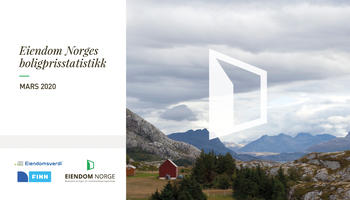
Continued growth in housing prices
Housing prices rose by 0.3 per cent in April 2022. Adjusted for seasonal variations, prices were unchanged.
House prices have risen by 6.2 per cent in the last year.
The average price for a home in Norway was NOK 4,483,328 at the end of April.
- House prices continued to rise in April. There are now signs that house price growth is leveling off, even though the underlying price growth is still strong in Eastern Norway, in Agder and Rogaland.
So far this year, a significant number of fewer homes have been put up for sale in Norway, both compared with the record year 2021 and the years before the pandemic. Much of the inflation in 2022 can be explained by the weak supply side triggered by the new Disposal Act, which came into force on 1 January.
- Although our members now report that the bottlenecks in obtaining condition reports are smaller than at the beginning of the year, we encourage home sellers to plan home sales well in advance and find information about the home, says CEO Henning Lauridsen in Eiendom Norge.
Fewer sales due to Easter
In April, 7,707 homes were sold in Norway, which is 18.8 per cent less than in the corresponding month in 2021.
So far this year, 28,383 homes have been sold in Norway. That is 15.2 per cent less than the same period last year.
In April, 8,399 homes were put up for sale in Norway, which is 23.8 per cent less than in the same month in 2021.
So far this year, 30,960 homes have been put up for sale. That is 11.9 per cent less than in the same period last year.
- Easter fell this year in early April and this affected both sales and the number of new homes on the market. So far this year, significantly fewer homes have been sold and put out than not only in 2021, but also before the pandemic. The decline in volume is applicable in almost all areas in Norway, but is particularly large in Eastern Norway, says Lauridsen.
It took an average of 29 days to sell a home in March, down from 30 days in March. Bergen and Bodø / Fauske had the shortest sales time with 15 days. Tromsø had the longest sales time with 39 days.
- The sales time has decreased significantly in many areas in Norway, and especially in Bergen, Bodø and Oslo, it is now very fast to sell a home, says Lauridsen.
Continued strong growth and great uncertainty
Follo had the strongest seasonally adjusted price development in April, with an increase of 0.8 per cent. Hamar w / Stange had the weakest seasonally adjusted price development with a seasonally adjusted decrease of 0.7 per cent.
Bodø / m Fauske has the strongest 12-month growth with an increase of 11.6 per cent, followed by Tønsberg m / Færder with 10.8 per cent.
Oslo had the weakest development in 12-month growth with an increase of 4.6 per cent. The weak 12-month growth in Oslo compared with other areas is due to the fact that Oslo in 2021 had a weak development in house prices.
- There is great uncertainty about the development of the global economy and monetary policy, and monetary policy in particular is important for house prices.
- The interest rate path Norge Bank published in March indicates an interest rate of 2.5 per cent by the end of 2023, which will dampen house price developments going forward. The big question is whether the interest rate path must be increased further to meet rising inflation both in Norway and internationally. In that case, we will probably see an even more moderate development in house prices in the future, Lauridsen concludes.
Eiendom Norge invites you to our annual conference on 30 May 2022.
The theme of this year's conference is developments in the housing market, monetary policy and the inflation target, regulation in the housing market, digitalisation and international unrest.






